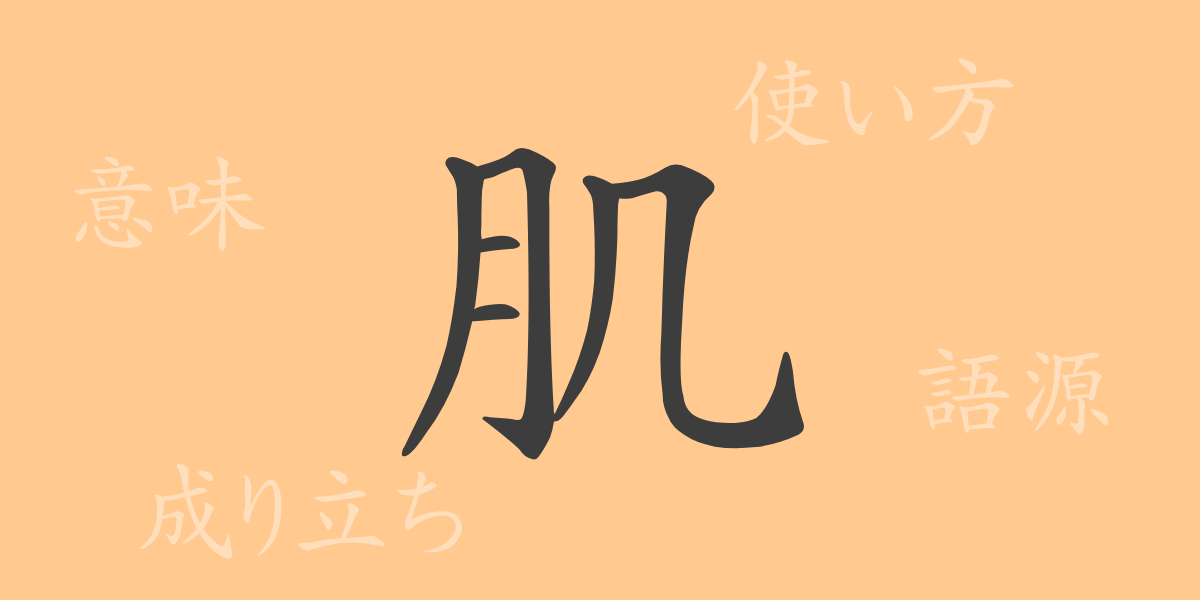Japanese culture is characterized by its intricacy and depth, and kanji are one of the key symbols of this cultural richness. Each kanji character carries its own meaning and history, weaving a profound tapestry of expression. In this article, we will delve into the common kanji “肌” (はだ, *hada*), exploring its origins, meanings, and uses, from everyday conversation to specialized contexts. Let’s explore the multifaceted world of “肌” and its significance in our daily lives.
The Origins of 肌 (*hada*)
The kanji “肌” (はだ, *hada*) has been used since ancient times to refer to the human body. Its origin can be traced back to a combination of the radical “肉” (*niku*), which signifies flesh or meat, and “此” (*shi*), which historically served as a demonstrative pronoun indicating a specific place. From this combination, “肌” came to represent the “surface of the body,” indicating its connection to the skin or outer layer of the body.
Meanings and Usage of 肌 (*hada*)
The kanji “肌” primarily refers to human skin, but its meanings extend beyond this. For instance, “肌触り” (*hada-zawari*) refers to physical texture or feel, “肌理” (*kime*) denotes fine details or texture, and “肌色” (*hada-iro*) indicates a specific shade or skin tone. Additionally, phrases like “空気が肌に合わない” (*kuuki ga hada ni awanai*) metaphorically suggest that the atmosphere or environment is not suitable for someone, showcasing its broader usage in expressing compatibility with surroundings.
Reading, Stroke Count, and Radical of 肌 (*hada*)
Understanding the reading and structural elements of the kanji “肌” can deepen its understanding.
- Reading: The kanji is read as “キ” (*ki*) in on’yomi (Chinese reading), but it is most commonly read as “はだ” (*hada*) in its kun’yomi (Japanese reading).
- Stroke Count: “肌” is composed of 6 strokes.
- Radical: The radical is “肉” (*niku*, flesh), indicating its connection to the body and physical aspects.
Idioms, Proverbs, and Expressions with 肌 (*hada*)
The kanji “肌” appears in numerous idiomatic expressions and sayings, each reflecting different aspects of its meaning. Here are some examples:
- 「肌を合わせる」(*hada o awaseru*): Literally means to have skin contact, but also refers to forming close relationships.
- 「肌理細やか」(*kime komayaka*): Describes a surface that is finely textured or smooth. Figuratively, it can mean meticulous attention to detail or careful consideration.
- 「肌が荒れる」(*hada ga areru*): Directly refers to rough or irritated skin but can also describe situations or moods deteriorating.
Summary of 肌 (*hada*)
The kanji “肌” is deeply intertwined with our daily lives, encompassing meanings that range from the literal sense of skin to metaphorical expressions of feeling and emotion. Exploring how “肌” is used, from straightforward descriptions to more nuanced metaphors, allows us to appreciate the rich expressiveness of the Japanese language. This kanji invites us to reexamine the depth of language and the subtle connections between words and culture.

























